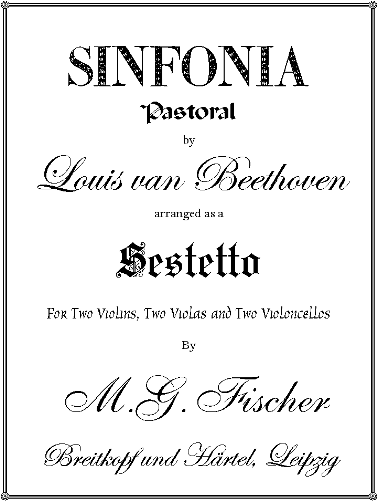Presents
Ludwig van Beethoven
Symphony No.6 in F Major, Op.68 "Pastoral"
Arranged for 2 Violins, 2 Violas and 2 Cellos by M.G. Fischer
 What???
Hold your horses....Beethoven himself arranged his Symphony No.2 for Piano Trio
and he asked his friend and student the composer and piano virtuoso Ferdinand
Ries to arrange it for string quartet, which he did and then went on to arrange
No.3, the Eroica, for piano quartet. And the well-known composer Johann Nepomuk
Hummel arranged all of Beethoven's symphonies for flute, violin, cello and
piano. For the first half of the 19th century, arranging large scale works for
chamber music ensembles was a common practice. Why? Because after the French
Revolution, European governments were highly suspicious of large gatherings of
men and discouraged them by means of police surveillance, fearing revolutionary
plotting. And, of course, it took a large group of men to rehearse and perform a
symphony. Add to this that a huge new market for chamber music came into
existence about this time as home music making became one of the most popular
pastimes for the emerging bourgeois classes of Western Europe. Both composers
and publishers, with an eye toward profits, made a regular practice of having
chamber music arrangements made of large scale works by well-known
composers.
While throughout the 19th century
various composers and arrangers tried their hand at arranging Symphony No.6 for
string quartet, the four strings simply were not enough to provide a satisfying
rendition of the work. On the other hand, the one contemporary arrangement of
the symphony made by Michael Gotthard Fischer (1773-1829) for 2 violins, 2
violas and 2 cellos creates the depth of sound necessary for such a work. Today,
unlike Hummel and Ries, Fischer and his music are virtually forgotten, although
this was not true while he lived. His vocal and organ music were well received
and he did not ignore chamber music, writing two string quartets, a string
quintet and a piano quartet. While Fischer was almost an exact contemporary of
Beethoven, there is no evidence to suggest they knew each other nor is their any
indication that Beethoven either asked or authorized Fischer to make his string
sextet arrangement of the symphony. On the other hand, Beethoven would certainly
have known of the arrangement and could well have expressed his dissatisfaction
since Fischer’s arrangement was brought out virtually at the same time that
Breitkopf and Härtel, the publisher to whom Beethoven sold the Symphony, brought
out the original orchestral parts and score in 1810. In all likelihood,
Beethoven was pleased as this gave his symphony a much wider audience than it
otherwise would have enjoyed at the time.
What???
Hold your horses....Beethoven himself arranged his Symphony No.2 for Piano Trio
and he asked his friend and student the composer and piano virtuoso Ferdinand
Ries to arrange it for string quartet, which he did and then went on to arrange
No.3, the Eroica, for piano quartet. And the well-known composer Johann Nepomuk
Hummel arranged all of Beethoven's symphonies for flute, violin, cello and
piano. For the first half of the 19th century, arranging large scale works for
chamber music ensembles was a common practice. Why? Because after the French
Revolution, European governments were highly suspicious of large gatherings of
men and discouraged them by means of police surveillance, fearing revolutionary
plotting. And, of course, it took a large group of men to rehearse and perform a
symphony. Add to this that a huge new market for chamber music came into
existence about this time as home music making became one of the most popular
pastimes for the emerging bourgeois classes of Western Europe. Both composers
and publishers, with an eye toward profits, made a regular practice of having
chamber music arrangements made of large scale works by well-known
composers.
While throughout the 19th century
various composers and arrangers tried their hand at arranging Symphony No.6 for
string quartet, the four strings simply were not enough to provide a satisfying
rendition of the work. On the other hand, the one contemporary arrangement of
the symphony made by Michael Gotthard Fischer (1773-1829) for 2 violins, 2
violas and 2 cellos creates the depth of sound necessary for such a work. Today,
unlike Hummel and Ries, Fischer and his music are virtually forgotten, although
this was not true while he lived. His vocal and organ music were well received
and he did not ignore chamber music, writing two string quartets, a string
quintet and a piano quartet. While Fischer was almost an exact contemporary of
Beethoven, there is no evidence to suggest they knew each other nor is their any
indication that Beethoven either asked or authorized Fischer to make his string
sextet arrangement of the symphony. On the other hand, Beethoven would certainly
have known of the arrangement and could well have expressed his dissatisfaction
since Fischer’s arrangement was brought out virtually at the same time that
Breitkopf and Härtel, the publisher to whom Beethoven sold the Symphony, brought
out the original orchestral parts and score in 1810. In all likelihood,
Beethoven was pleased as this gave his symphony a much wider audience than it
otherwise would have enjoyed at the time.
We are pleased to reprint the original edition and are certain that it will not only make a strong impression in the concert hall but will also give much pleasure to good amateur players for whom it was no doubt intended.
Parts: $39.95